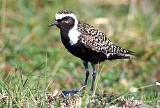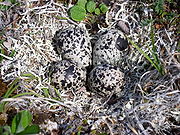
American Golden Plover
Encyclopedia
The American Golden Plover () is a medium-sized plover
.
 Adults are spotted gold and black on the crown, back and wings. Their face and neck are black with a white border; they have a black breast and a dark rump. The legs are black.
Adults are spotted gold and black on the crown, back and wings. Their face and neck are black with a white border; they have a black breast and a dark rump. The legs are black.
It is similar to two other golden plovers, Eurasian and Pacific. The American Golden Plover is smaller, slimmer and relatively longer-legged than Eurasian Golden Plover
(Pluvialis apricaria) which also has white axillary (armpit) feathers. It is more similar to Pacific Golden Plover
(Pluvialis fulva) with which it was once considered conspecific under the name "Lesser Golden Plover". The Pacific Golden Plover is slimmer than the American species, has a shorter primary projection, and longer legs, and is usually yellower on the back.
These birds forage for food on tundra, fields, beaches and tidal flats, usually by sight. They eat insects and crustaceans, also berries.
 The breeding habitat of American Golden Plover is Arctic tundra from northern Canada
The breeding habitat of American Golden Plover is Arctic tundra from northern Canada
and Alaska
. They nest on the ground in a dry open area. They are migratory
and winter in southern South America
. They follow an elliptical migration path; northbound birds pass through Central America
about January–April and stage in great numbers in places like Illinois before their final push north. In fall, they take a more easterly route, flying mostly over the western Atlantic and Caribbean Sea
to the wintering grounds in Patagonia
. The bird has one of the longest known migratory routes of over 25,000 miles. Of this, 2,400 miles is over open ocean where it cannot stop to feed or drink. It does this from body fat stores that it stocks up on prior to the flight. It is a regular vagrant to western Europe
.
A comparison of dates and migratory patterns leads to the conclusion that Eskimo Curlew
s and American Golden Plovers were the most likely shore birds to have attracted the attention of Christopher Columbus
to nearby America
in early October 1492, after 65 days at sea out of sight of land.
Large numbers were shot in the late 19th century and the population has never fully recovered.
Plover
Plovers are a widely distributed group of wading birds belonging to the subfamily Charadriinae. There are about 40 species in the subfamily, most of them called "plover" or "dotterel". The closely related lapwing subfamily, Vanellinae, comprises another 20-odd species.Plovers are found throughout...
.

It is similar to two other golden plovers, Eurasian and Pacific. The American Golden Plover is smaller, slimmer and relatively longer-legged than Eurasian Golden Plover
Eurasian Golden Plover
The European Golden Plover is a largish plover. This species is similar to two other golden plovers. American Golden Plover, Pluvialis dominiica, and Pacific Golden Plover, Pluvialis fulva, are both smaller, slimmer and relatively longer-legged than European Golden Plover, and both have grey...
(Pluvialis apricaria) which also has white axillary (armpit) feathers. It is more similar to Pacific Golden Plover
Pacific Golden Plover
The Pacific Golden Plover is a medium-sized plover.The 23–26 cm long breeding adult is spotted gold and black on the crown, back and wings. Its face and neck are black with a white border and it has a black breast and a dark rump. The legs are black...
(Pluvialis fulva) with which it was once considered conspecific under the name "Lesser Golden Plover". The Pacific Golden Plover is slimmer than the American species, has a shorter primary projection, and longer legs, and is usually yellower on the back.
These birds forage for food on tundra, fields, beaches and tidal flats, usually by sight. They eat insects and crustaceans, also berries.

Canada
Canada is a North American country consisting of ten provinces and three territories. Located in the northern part of the continent, it extends from the Atlantic Ocean in the east to the Pacific Ocean in the west, and northward into the Arctic Ocean...
and Alaska
Alaska
Alaska is the largest state in the United States by area. It is situated in the northwest extremity of the North American continent, with Canada to the east, the Arctic Ocean to the north, and the Pacific Ocean to the west and south, with Russia further west across the Bering Strait...
. They nest on the ground in a dry open area. They are migratory
Bird migration
Bird migration is the regular seasonal journey undertaken by many species of birds. Bird movements include those made in response to changes in food availability, habitat or weather. Sometimes, journeys are not termed "true migration" because they are irregular or in only one direction...
and winter in southern South America
South America
South America is a continent situated in the Western Hemisphere, mostly in the Southern Hemisphere, with a relatively small portion in the Northern Hemisphere. The continent is also considered a subcontinent of the Americas. It is bordered on the west by the Pacific Ocean and on the north and east...
. They follow an elliptical migration path; northbound birds pass through Central America
Central America
Central America is the central geographic region of the Americas. It is the southernmost, isthmian portion of the North American continent, which connects with South America on the southeast. When considered part of the unified continental model, it is considered a subcontinent...
about January–April and stage in great numbers in places like Illinois before their final push north. In fall, they take a more easterly route, flying mostly over the western Atlantic and Caribbean Sea
Caribbean Sea
The Caribbean Sea is a sea of the Atlantic Ocean located in the tropics of the Western hemisphere. It is bounded by Mexico and Central America to the west and southwest, to the north by the Greater Antilles, and to the east by the Lesser Antilles....
to the wintering grounds in Patagonia
Patagonia
Patagonia is a region located in Argentina and Chile, integrating the southernmost section of the Andes mountains to the southwest towards the Pacific ocean and from the east of the cordillera to the valleys it follows south through Colorado River towards Carmen de Patagones in the Atlantic Ocean...
. The bird has one of the longest known migratory routes of over 25,000 miles. Of this, 2,400 miles is over open ocean where it cannot stop to feed or drink. It does this from body fat stores that it stocks up on prior to the flight. It is a regular vagrant to western Europe
Europe
Europe is, by convention, one of the world's seven continents. Comprising the westernmost peninsula of Eurasia, Europe is generally 'divided' from Asia to its east by the watershed divides of the Ural and Caucasus Mountains, the Ural River, the Caspian and Black Seas, and the waterways connecting...
.
A comparison of dates and migratory patterns leads to the conclusion that Eskimo Curlew
Eskimo Curlew
The Eskimo or the "Northern Curlew" is a critically endangered shorebird, now considered by many to be extinct.-Taxonomy:The Eskimo Curlew is one of eight species of curlew, and is classed with them in the genus Numenius. It was formerly placed in the separate genus Mesoscolopax. Numenius is...
s and American Golden Plovers were the most likely shore birds to have attracted the attention of Christopher Columbus
Christopher Columbus
Christopher Columbus was an explorer, colonizer, and navigator, born in the Republic of Genoa, in northwestern Italy. Under the auspices of the Catholic Monarchs of Spain, he completed four voyages across the Atlantic Ocean that led to general European awareness of the American continents in the...
to nearby America
Americas
The Americas, or America , are lands in the Western hemisphere, also known as the New World. In English, the plural form the Americas is often used to refer to the landmasses of North America and South America with their associated islands and regions, while the singular form America is primarily...
in early October 1492, after 65 days at sea out of sight of land.
Large numbers were shot in the late 19th century and the population has never fully recovered.

